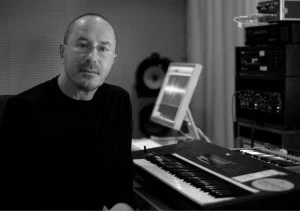WHEN: Thursday, Feb. 26th, 5:30PM (Dept. Colloquium Series) //// WHERE: NYU Music Dept. Rm 320 (24/32 Waverly Place, NY 10003) /// This event is free and open to the public.
Curtis Roads, (UC Santa Barbara), will present a lecture referencing hi s chapter Rhythm in Electroacoustic Music from his newest book Composing Electronic Music: A New Aesthetic (Oxford Press, 2012) in the Department of Music Colloquium Series. He’ll also participate in the Spatialized Music Concert.
s chapter Rhythm in Electroacoustic Music from his newest book Composing Electronic Music: A New Aesthetic (Oxford Press, 2012) in the Department of Music Colloquium Series. He’ll also participate in the Spatialized Music Concert.
Bio
Curtis Roads creates, teaches, and pursues research in the interdisciplinary territory spanning music and sound technology. He studied computer music composition at California Institute of the Arts and the University of California, San Diego (UCSD) and received a Doctorate from the Université Paris 8.
He was Editor and Associate Editor of Computer Music Journal (The MIT Press) from 1978 to 2000, and cofounded the International Computer Music Association (ICMA) in 1979.
A researcher in computer music at MIT (1980-1986), he also worked in the software industry for a decade. He taught electronic music composition at Harvard University and sound synthesis techniques at the University of Naples. He was appointed Director of Pedagogy at Les Ateliers UPIC (later CCMIX) and Lecturer in the Music Department of the Université Paris 8.
 Among his books are the anthologies Foundations of Computer Music(1985, The MIT Press) and The Music Machine (1989, The MIT Press). His textbook The Computer Music Tutorial (1996, The MIT Press) is widely adopted as a standard classroom text and has been published in French (1999, second edition 2007), Japanese (2001), and Chinese (forthcoming) editions. He edited the anthology Musical Signal Processing in 1997. His book, Microsound (2001, The MIT Press) presents the techniques and aesthetics of composition with sound particles.
Among his books are the anthologies Foundations of Computer Music(1985, The MIT Press) and The Music Machine (1989, The MIT Press). His textbook The Computer Music Tutorial (1996, The MIT Press) is widely adopted as a standard classroom text and has been published in French (1999, second edition 2007), Japanese (2001), and Chinese (forthcoming) editions. He edited the anthology Musical Signal Processing in 1997. His book, Microsound (2001, The MIT Press) presents the techniques and aesthetics of composition with sound particles.
A pioneer in the development of granular synthesis (1974), he also developed (with Alberto de Campo) the program PulsarGenerator (2001), distributed by the Center for Research in Electronic Art Technology (CREATE) at UCSB. Another invention is the Creatovox, an expressive instrument for virtuoso performance that is based on the synthesis of sound grains and other sound particles. The Creatovox, developed in collaboration with Alberto de Campo, was first demonstrated to the public in March 2000. In 2008, CREATE released EmissionControl, a new program for sound granulation written by David Thall in consultation with Curtis Roads.
His composition Clang-tint (1994) was commissioned by the Japan Ministry of Culture (Bunka-cho) and the Kunitachi College of Music, Tokyo. His music is available on compact discs produced by the MIT Media Laboratory, Wergo, OR, Mode, and Asphodel. His collection of electronic music compositions POINT LINE CLOUD won the Award of Distinction at the 2002 Ars Electronica in Linz and was released as a CD + DVD on the Asphodel label in 2005.
He is keenly interested in the integration of electronic music with visual and spatial media, as well as the visualization and sonification of data.
Since 2004, he has been researching a new method of sound analysis that is the analytical counterpart of granular synthesis called dictionary-based pursuit (DBP). This research was sponsored by the National Science Foundation in 2007-2009.
Roads’s new book is Composing Electronic Music: A New Aesthetic (forthcoming) Oxford University Press. A new revised edition of The Computer Music Tutorial by The MIT Press is also in progress.

